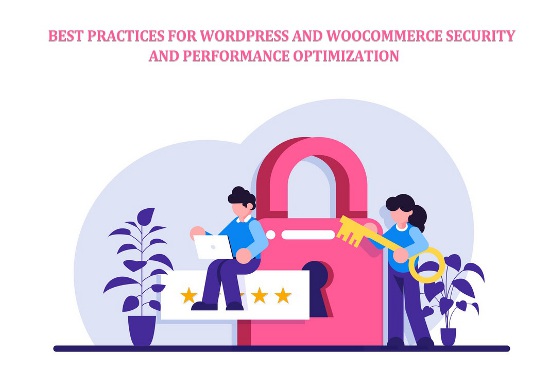As a website owner, you know that security and performance are crucial factors for the success of your website. With so much competition on the web, you must ensure your website is secure and performs well to attract and retain visitors.


In this era of online threats and cyber-attacks, website security is more important than ever. Your website contains sensitive data that can be compromised if not properly secured.
On the other hand, website performance is also critical to ensuring that your visitors have a positive user experience. Slow-loading websites can drive away visitors, leading to lost revenue and decreased search engine rankings.
How can you ensure your WordPress and WooCommerce website is secure and performing optimally? This guide will explore the best practices for WordPress and WooCommerce security and performance optimization.
From installing security plugins to optimizing images and databases, we will cover everything you need to know to keep your website secure and performing at its best.
By following these best practices, you can protect your website from cyber threats, speed up your website’s loading times, and provide visitors with a seamless and enjoyable user experience. So, let’s get started!
1. Use a web application firewall (WAF)
A web application firewall (WAF) is a security tool that helps protect your website from malicious traffic. A WAF sits between your website and the internet and filters incoming traffic to your website.
It analyzes the traffic for known attack patterns, such as SQL injection, cross-site scripting (XSS), and brute force attacks. If it detects an attack, the WAF can block the traffic, preventing the attack from reaching your website.
One popular WAF for WordPress is Cloudflare’s Firewall. The Cloudflare Firewall provides a range of security features, including a WAF that can detect and block malicious traffic.
The WAF is powered by Cloudflare’s threat intelligence, which means it can quickly detect and block new and emerging threats. The Cloudflare Firewall also provides additional security features, such as bot protection, DDoS protection, and IP reputation-based blocking.
2. Implement a disaster recovery plan
A disaster recovery plan is a set of procedures that you can use to quickly restore your website in the event of a disaster, such as a hack or a technical issue.
Your disaster recovery plan should include the following:
- Regular website backups.
- A method for restoring your website.
- A way to test your project to ensure it works.
Several backup solutions are available for WordPress, such as UpdraftPlus and Jetpack Backup.
These solutions can automate the backup process, so you don’t have to worry about manually backing up your website. In a disaster, you can use the backup to restore your website quickly.
Testing your disaster recovery plan regularly is essential to ensure it works. You can use WooCommerce Loop Description a staging environment to test your plan without affecting your live website. This will give you the confidence to restore your website during a disaster quickly.
3. Use a content delivery network (CDN) with dynamic caching
A content delivery network (CDN) is a network of servers located in different geographic locations that work together to deliver website content to visitors.
CDN can help to speed up the delivery of website content by serving cached versions of your website’s content from the server closest to the visitor’s location.
When a user requests content from your website, the CDN serves the content from the closest server to the user. This can significantly improve your website’s performance, as the content is done more quickly.
However, serving dynamic content like product listings or shopping carts can take more work. This is where dynamic caching comes in.
Dynamic caching caches content that changes frequently, such as product listings or shopping carts, which can reduce the load on your web server and improve your website’s performance.
One popular CDN with dynamic caching for WordPress is Cloudflare’s CDN. Cloudflare’s CDN provides dynamic caching for WordPress, which can significantly improve your website’s performance.
Cloudflare’s CDN provides additional performance features like image optimization and minification.
4. Use a managed hosting provider
A managed hosting provider handles all the technical aspects of hosting your website, including security, updates, and performance optimization. This can save you time and ensure your website is always secure and performs well.
Managed hosting providers like WP Engine and Kinsta are specifically designed for WordPress and WooCommerce and offer a range of features, including automatic backups, security scanning, and performance optimization.
Using a managed hosting provider can also improve your website’s security. Managed hosting providers typically provide additional security features, such as malware scanning and vulnerability scanning.
They also typically provide automatic updates to WordPress and WooCommerce, which can ensure that your website is always running the latest, most secure version.
5. Optimize your database
Your WordPress database stores your website’s content, including posts, pages, comments, and user data. Over time, your database can become bloated with unnecessary data, slowing down your website.
By optimizing your database, you can remove unnecessary data and improve your website’s performance.
One popular plugin for optimizing your WordPress database is WP-Optimize. WP-Optimize can remove unnecessary data from your database, such as post revisions, spam comments, and trashed items.
It can also optimize your database tables, improving your website’s performance. WP-Optimize also provides additional features, such as image compression and lazy loading.
Another popular plugin for optimizing your WordPress database is WP Database Optimizer. WP Database Optimizer can remove unnecessary data from your database, such as post revisions, spam comments, and trashed items.
It can also optimize your database tables, improving your website’s performance. WP Database Optimizer also provides additional features, such as backup, restore, and scheduling optimizations.
Optimizing your database can significantly improve your website’s performance, as the database can be queried more quickly. This can reduce the load on your web server and enhance your website’s response time.
Conclusion
As we end this guide on WordPress and WooCommerce security and performance optimization, it’s essential to reflect on the significance of website security and performance in today’s online landscape.
With millions of websites competing for the attention of online users, you need to ensure that your website stands out and delivers a seamless and secure user experience.
By following the best practices outlined in this guide, you can protect your website from online threats, improve your website’s loading times, and enhance the overall user experience.
But it’s important to remember that website security and performance are not one-time tasks; they require ongoing effort and attention.
As technology advances and online threats evolve, staying updated with the latest security and performance trends and best practices is crucial. So, regularly check for updates and monitor your website’s performance and security to ensure that it continues to meet the needs of your visitors.
















